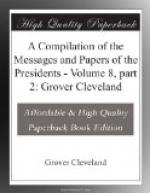Zachary Taylor was born in Orange County, Va., November 24, 1784. He was the third son of Richard Taylor, a colonel in the War of the Revolution, who was conspicuous for his zeal and courage. In 1785 his father removed to Kentucky, then a sparsely occupied county of Virginia, and made his home near the present city of Louisville, where he died. Zachary had but little opportunity for attending school in this new settlement, but was surrounded during all the years of his childhood and early manhood by conditions and circumstances well adapted to form the character illustrated by his eventful career. In 1808 he was appointed a Lieutenant in the Seventh Infantry, and in 1810 was promoted to the grade of captain in the same regiment. The same year was married to Miss Margaret Smith, of Maryland. For meritorious conduct in defending Fort Harrison, on the Wabash River, against the Indians received the brevet of major. In 1814 commanded in a campaign against hostile Indians and their British allies on Rock River. Was made lieutenant-colonel of the First Infantry in 1819, and in 1832 became full colonel of that regiment, with headquarters at Fort Crawford, Prairie du Chien. Was occupied with his regiment fighting the Indians in the Black Hawk and other campaigns until 1836, when he was transferred to Florida for service in the Seminole War. For gallant conduct there the next year received the brevet of brigadier-general, and in 1838 was appointed to the chief command in Florida. In 1840 was assigned to command the southern division of the western department of the Army. About this time he made his family home at Baton Rouge, La. In 1845 was ordered to the defense of Texas, which had been annexed to the United States. He went to Corpus Christi, and on March 8, 1846, advanced, and after some fighting, in which he routed and drove the enemy across the Rio Grande, on May 18 occupied Matamoras. He remained there for a short period, obtaining reenforcements. In September fought the enemy at Monterey and captured that town. The following February fought and won the battle of Buena Vista. In the meantime, besides engagements less important, he had won the victories of Palo Alto and Resaca de la Palma, which created great enthusiasm throughout the Union. The terms of capitulation granted by him to the enemy at Monterey were not approved by the Government at Washington. Soon after the battles of Palo Alto and Resaca de la Palma he received the rank of brevet major-general, and on June 27, 1846, was appointed major-general and was commander in chief of all the American forces in Mexico until Major-General Scott was ordered there in 1846. The latter part of November returned to his home in Louisiana. Upon his return to the United States he was received wherever he went with popular demonstrations. Was nominated for President by the national convention of the Whig party at Philadelphia on June 7, 1848, on the fourth ballot, defeating General Scott, Mr. Clay, and Mr. Webster. At the election on November 7 the Whig ticket (Taylor and Fillmore) was successful, receiving 163 electoral votes, while the Democratic candidates (Cass and Butler) each received 127 votes. He was inaugurated March 5, 1849, and died in Washington City July 9, 1850. Was buried in Cave Hill Cemetery, Louisville, Ky.




